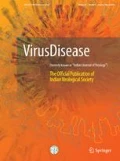Abstract
The 50 % tissue culture infectious dose (TCID50) is still one of the most commonly used techniques for estimating virus titers. However, the traditional TCID50 assay is time consuming, susceptible to subjective errors and generates only quantal data. Here, we describe a colorimetric-based approach for the titration of Enterovirus 71 (EV71) using a modified method for making virus dilutions. In summary, the titration of EV71 using MTT or MTS staining with a modified virus dilution method decreased the time of the assay and eliminated the subjectivity of observational results, improving accuracy, reproducibility and reliability of virus titration, in comparison with the conventional TCID50 approach (p < 0.01). In addition, the results provided evidence that there was better correlation between a plaquing assay and our approach when compared to the traditional TCID50 approach. This increased accuracy also improved the ability to predict the number of virus plaque forming units present in a solution. These improvements could be of use for any virological experimentation, where a quick accurate titration of a virus capable of causing cell destruction is required or a sensible estimation of the number of viral plaques based on TCID50 of a virus is desired.





Similar content being viewed by others
References
Anderson P, Alm S, Edman K, Lindberg AM. A novel and rapid method to quantify cytolytic replication of picornaviruses in cell culture. J Virol Methods. 2005;130:117–23.
Baylis AS, Shah N, Minor DP. Evaluation of different assays for the detection of parvovirus B19 DNA in human plasma. J Virol Methods. 2004;121:7–16.
Davis BD, Dulbecco R, Eisen HN, Ginsberg HS, Wood WB. Nature of viruses. In: Microbiology. New York: Harper and Row; 1972. p. 1044–1053.
Distefano DJ, Gould SL, Munshi S, Robinson DK. Titration of human-bovine rotavirus reassortants using a tetrazolium-based colorimetric end-point dilution assay. J Virol Methods. 1995;55:199–208.
Dulbecco R, Vogt M. Plaque formation and isolation of pure lines with poliomyelitis viruses. J Exp Med. 1954;99:167–82.
Heldt CL, Hernandez R, Mudiganti U, Gurgel PV, Brown DT, Carbonell RG. A colorimetric assay for viral agents that produce cytopathic effects. J Virol Methods. 2006;135:56–65.
Huang C, Hung JJ, Wu CY, Chien MS. Multiplex PCR for rapid detection of pseudorabies virus, porcine parvovirus and porcine circoviruses. Vet Microbiol. 2004;101:209–14.
LaBarre DD, Lowy RJ. Improvements in methods for calculating virus titer estimates from TCID50 and plaque assays. J Virol Methods. 2001;96:107–26.
Levi R, Beeor-Tzahar T, Arnon R. Microculture virus titration-a simple colourimetric assay for influenza virus titration. J Virol Methods. 1995;52:55–64.
Lin YC, Wu CN, Shih SR, Ho MS. Characterization of a Vero cell-adapted virulent strain of enterovirus 71 suitable for use as a vaccine candidate. Vaccine. 2002;20:2485–93.
Prikhod’ko GG, Vasilyeva I, Reyes H, Wong S, Brown KE, Jameson T, Busby TF. Evaluation of a new LightCycler reverse transcription-polymerase chain reaction infectivity assay for detection of human parvovirus B19 in dry-heat inactivation studies. Transfusion. 2005;45:1011–9.
Reed LJ, Muench H. A simple method of estimating fifty percent endpoints. Am J Epidemiol. 1938;27:4931–7.
Rubino KL, Nicholas JA. A novel, spectrophotometric microneutralization assay for respiratory syncytial virus. J Virol Methods. 1992;39:55–67.
Schmidtke M, Schnittler U, Jahn B, Dahse HM, Stelzner A. A rapid assay for evaluation of antiviral activity against coxsackie virus B3, influenza virus A, and herpes simplex virus type 1. J Virol Methods. 2001;95:133–43.
Shih SR, Tsai MC, Tseng SN, Won KF, Shia KS, Li WT, Chern JH, Chen GW, Lee CC, Lee YC, Peng KC, Chao YS. Mutation in Enterovirus 71 capsid protein VP1 confers resistance to the inhibitory effects of pyridylimidazolidinone. Antimicrob Agents Chemother. 2004;48:3523–9.
Watanabe W, Konno K, Ijichi K, Inoue H, Yokota T, Shigeta S. MTT colorimetric assay system for the screening of anti-orthomyxo- and anti-paramyxoviral agents. J Virol Methods. 1994;48:257–65.
Acknowledgments
We wish to thank Professor Peter C. McMinn (Central Clinical School, University of Sydney, Australia) for providing the cloned virus and the cells and Dr Julian Druce (Polio reference laboratory, Victorian Infectious Disease Reference Laboratory, Parkville, VIC, Australia) for providing us with the clinical isolate used. We also thank Dr. Jillian Shaw for reading the manuscript.
Author information
Authors and Affiliations
Corresponding author
Rights and permissions
About this article
Cite this article
Pourianfar, H.R., Javadi, A. & Grollo, L. A Colorimetric-Based Accurate Method for the Determination of Enterovirus 71 Titer. Indian J. Virol. 23, 303–310 (2012). https://doi.org/10.1007/s13337-012-0105-0
Received:
Accepted:
Published:
Issue Date:
DOI: https://doi.org/10.1007/s13337-012-0105-0




